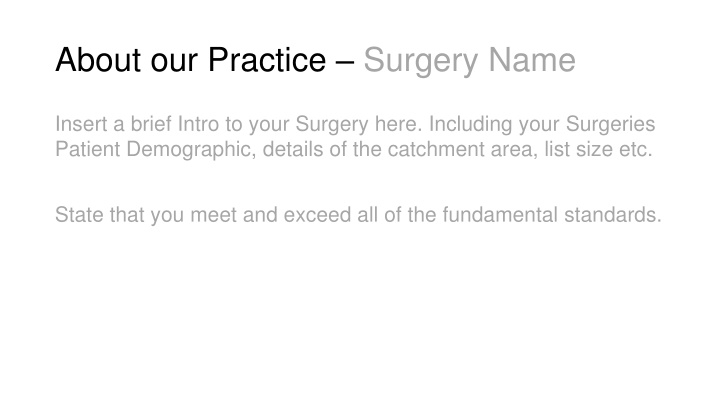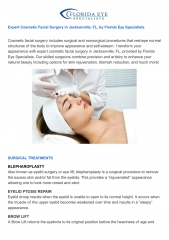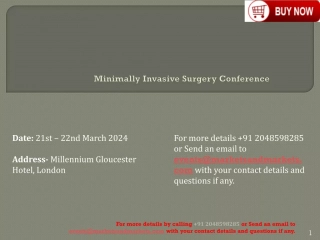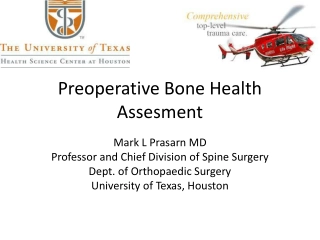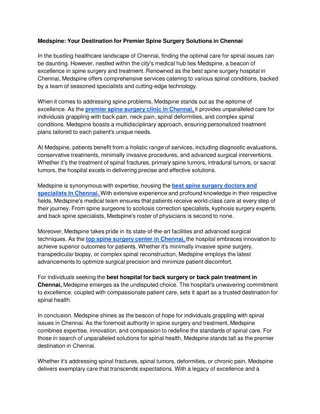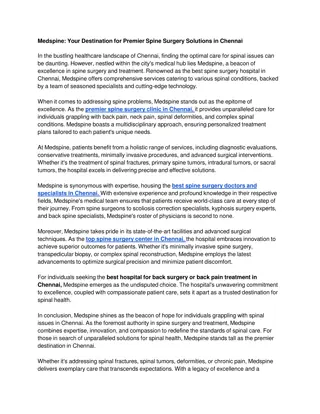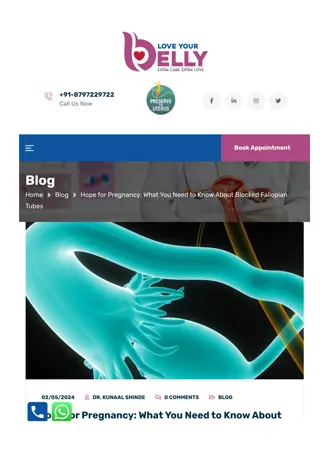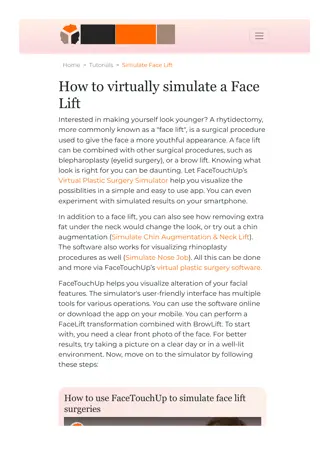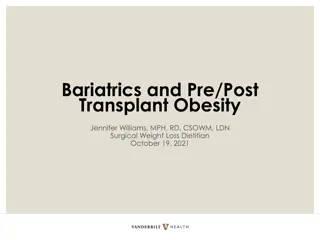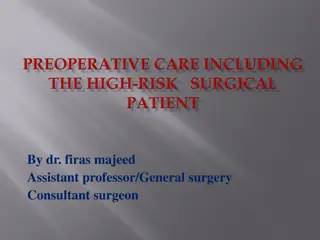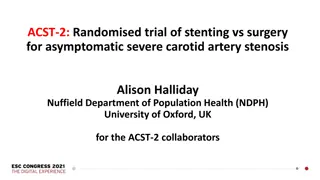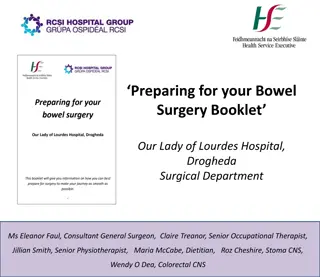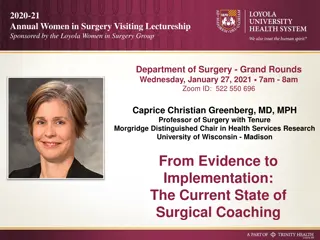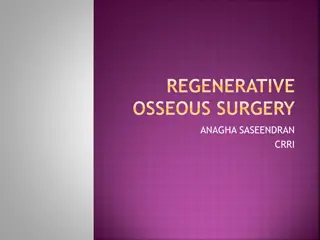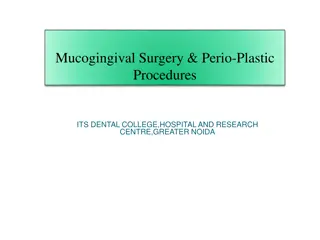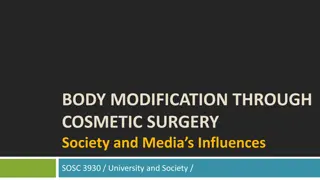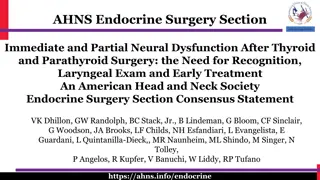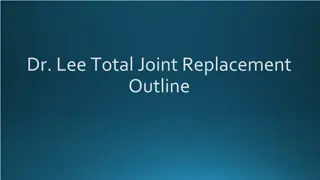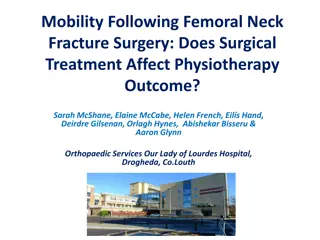Comprehensive Intro to Our Surgery Practice
Delivering exceptional surgical care to a diverse patient demographic within our catchment area, ensuring we meet and exceed all fundamental standards. Our commitment to safety is evident in our robust mechanisms for incident reporting, transparency, and safeguarding protocols for adults and children.
Download Presentation

Please find below an Image/Link to download the presentation.
The content on the website is provided AS IS for your information and personal use only. It may not be sold, licensed, or shared on other websites without obtaining consent from the author.If you encounter any issues during the download, it is possible that the publisher has removed the file from their server.
You are allowed to download the files provided on this website for personal or commercial use, subject to the condition that they are used lawfully. All files are the property of their respective owners.
The content on the website is provided AS IS for your information and personal use only. It may not be sold, licensed, or shared on other websites without obtaining consent from the author.
E N D
Presentation Transcript
About our Practice Surgery Name Insert a brief Intro to your Surgery here. Including your Surgeries Patient Demographic, details of the catchment area, list size etc. State that you meet and exceed all of the fundamental standards.
Previous CQC Inspection - Musts Must Action taken & improvements made: Must Action taken & improvements made: Must Action taken & improvements made:
Previous CQC Inspection - Musts Must Action taken & improvements made: Must Action taken & improvements made: Must Action taken & improvements made:
Previous CQC Inspection - Shoulds Should Action taken & improvements made: Should Action taken & improvements made: Should Action taken & improvements made:
Previous CQC Inspection - Shoulds Should Action taken & improvements made: Should Action taken & improvements made: Should Action taken & improvements made:
What we do well - Safe Our safety performance and consistency of performance over time. Give examples Mechanisms to report and record safety incidents, concerns and near misses, and allegations of abuse. Give examples
What we do well - Safe How we investigate, share lessons learned and action following internal and external incidents and near misses. Give examples Openness and transparency when things go wrong. Give examples Responding to safety alerts. Give examples
What we do well - Safe Our approach and systems for safeguarding adults and children, and child protection. Give examples Reliability of systems, processes and operating procedures. Give examples
What we do well - Safe Our Staffing levels Give examples Assessing and responding to individual patient risk and carer feedback Give examples Responding to medical emergencies Give examples Responding to staff concerns Give examples Responding to busy periods/ staff shortages Give examples
What we do well - Safe Understanding and management of foreseeable risks:, including Changes in demand Seasonal or weather Disruption to staffing levels of facilities Emergency / major incident response plans Give examples
Where we go above and beyond- Safe Patients are kept safe because there are arrangements in place for staff to report and learn from key safety risks. The practice has a system in place for reporting, recording and monitoring significant events over time. Our staff understand and fulfil their responsibilities to raise concerns and report incidents and near misses. The surgery highly values information about safety and uses it to promote learning and improvement. All of our staff recognise that they have a part to play in risk management. We have enough staff in the practice to keep patients safe. Our whole surgery team is engaged in reviewing and improving safety and safeguarding systems. All of our staff are appropriately checked to make sure that they are safe to work with vulnerable people.
What we do well - Caring Staff attitudes and behaviours Give examples for each bullet point Interactions and relationships between staff and people who use the service. Privacy and dignity is always respected, particularly during physical or intimate care Care is dignified and takes into account the patient s physical support needs and their individual preferences, habits, culture and faith Respect for confidentiality Staff respond compassionately to patients concerns, their physical pain, discomfort or emotional distress.
What we do well - Caring Understanding among people who use the services about their care and treatment and their Involvement in planning and making decisions about care Give examples for each bullet point Supported to make informed decisions and give informed consent. Use of best interest decision making for people without the capacity to consent
What we do well - Caring Support we offer during bereavement Give examples for each bullet point How we work with other forms of Patient support
Where we go above and beyond- Caring Patients feel like they are treated with compassion, dignity and respect. Patient survey shows this (remote monitoring) Our feedback from patients about their care and treatment is consistently positive. We have positive examples to demonstrate how patient's lives are enhanced through the caring and supportive actions of our staff. We value and act upon patient's choices. We have a strong patient-centred culture - our mission statement was developed and reviewed with patients. Our patients are encouraged to use the first names of our staff, which promotes a caring environment. Our surgery staff do not wear uniforms as patients thought it was a barrier to building a rapport with them. One of the GP partners always comes out and welcomes new patients and introduces them to the surgery team. Data shows that our patients rate our practice much higher than others for all aspects of care.
What we do well - Responsive Appropriateness of service planning and delivery to meet needs of different groups Give examples for each bullet point Approach to planning joint working arrangements and integrated pathways Relationships with commissioners, other providers and stakeholders. Planning and supporting different groups in respect of their needs and protected equality characteristics Approach to addressing inequalities Meeting needs of people in vulnerable circumstances Addressing barriers to care Facilities and equipment are available, in sufficient quantities and meets people s needs.
What we do well - Responsive People can make appointments to access the right care at the right time. Including: Appointments systems, triage Responding to urgent needs Cancellations Appointments at home or over the telephone for those that need them Use of technology to support access Repeat prescriptions Access to diagnostic services OOH: Monitoring of volume of calls and time taken to respond to calls. Patients wait as little as possible for appointments, treatment or care Urgent clinical and medical needs assessed and acted on.
What we do well - Responsive Needs of people are understood, including: individual preferences, habits, culture, faith. Give examples for each bullet point Needs are understood throughout their care and treatment Referral Transition Patient needs influence care and treatment Referrals: Timeliness Involvement Support for people Information sharing with other agencies Follow up of test results
What we do well - Responsive Complaints process. Give examples for each bullet point Complaints handling, support, advocacy Listening, learning and service improvements as a result of feedback/complaints. Openness and transparency.
Where we go above and beyond- Responsive We have a good range of appointments available that suits patients needs and it is easy to make an appointment. We offer a comprehensive range of services in house with specialists available in resulting in lower referal rates and waiting times. We are continuously wanting to improve services and experiences of patients. We have initiated positive service improvements for our patients that are above and beyond our contractual obligations. Patients are able to access a wide range of services at the practice, enabling patients to be treated nearer their home. We have implemented suggestions for improvements and made changes to the way we deliver services as a consequence of feedback from the Patient Participation Group There is an accessible complaints system at the surgery and we respond and learn quickly to issues raised. We have documented how we review the appointments system and the service we provide and have implemented changes to meet patinets needs to be inclusive to all. We work innovatively with other health and social care providers in the provision of additional services for our patients.
Where we go above and beyond- Responsive We have adopted innovative methods to encourage patients from vunerable groups to access care services. Our patients have good access to the practice and have a named GP or GP of choice. We offer a range of appointments incuding late evening and Saturday appointments. We have funded a transport service for the surgery as well as set up a dispensing service for patinets living more than a mile from the surgery. Our practice has good facilities and is well equipped to treat patients and meet their needs. Our practice always takes account of patient's personal, cultural, social and religious needs. Our surgery works closely with other local surgeries to provide access to other comprehensive services that we do not run such as midwifery services. Our staff have undertaken training to provide services that are usually offered in the hospital meaning that they do not have to travel long distances for the care. Our practice performance for delivering appointments far exceeds what is expected. Our practice provides rapid response and emergency care to patients locally until and ambulance arrives. We offer children same day appointments.
What we do well - Effective Ensuring informed consent Give examples for each bullet point Assessment of Gillick competency of children and young people Current guidance, standards and best practice are used to inform the appropriate management and use of medicines Assessment, diagnoses and care planning Patients referred appropriately Assessment and recording of capacity and consent Supporting people to make choices and informed consent Review of care and treatment through clinical audits Prescribing
What we do well - Effective Use of data/information to improve the quality of services Give examples for each bullet point Benchmarking of patient outcomes Key metrics on local clinical audits with peer review
What we do well - Effective Appropriately qualified and competent staff with the right skills and experience. Give examples for each bullet point Training and professional development: Including Induction, One to one meetings, Appraisals, Identifying learning needs, Coaching and mentoring, Clinical supervision, Revalidation for doctors Processes for managing the performance of staff and their professional development Poor or variable practice identified across the practice team and responded to. Equipment and facilities used reflect best practice
What we do well - Effective Effectiveness of formal and informal joint working arrangements with other providers. Including between in hours and out-of-hours general practice. Give examples for each bullet point Approaches to supporting people with complex needs. GP practice facilitates access to other healthcare, advice and support services for patients (navigator/coordinator role) Provision of care through: Joint assessment Multi-disciplinary working sharing information co-ordination with services outside the organisation
What we do well - Effective Identification of patients that may need extra support. Including Those receiving end of life care At risk of developing a Longterm Condition Carers Assessments for new patients Give examples for each bullet point Supporting patients to live healthier lives Screening programmes including cervical screening. Vaccination programmes
Where we go above and beyond- Effective We have a lower than local and national rate for emergency admissions and contact with A&E and out of hours departments. The practice offers patients services and continuity they want so patient satisfaction is high. The practice is inclusive for all developing positive and high levels of engagement and support for both patients and staff. We have systems in place to ensure that all clinicians are up to date with both the NICE guidelines and other locally agreed guidelines. Our practice is performing highly when compared to neighbouring practices within the CCG. Our emergency unplanned admissions in all groups of patinets were lower than the local average We use innovative and proactive methods to improve patient outcomes and engage well with other local providers to share best practice. Some of our clinical staff have advanced skills allowing us to improve patient outcomes. We offer health promotions for patients and offer a number of exercise initiatives as a result. Our patients are regularly reviewed to assess the effectiveness of their care and treatment.
How we Manage Well-Led Vision and values A clear strategy
How we Manage Well-Led Leadership: Development strategy Leadership priorities Leadership behaviour Visibility throughout the organisation. Give examples for each bullet point Culture Performance management Openness and transparency Equality diversity and human rights Recognising and rewarding good practice Staff wellbeing HR practices Team working Duty of candour
How we Manage Well-Led Mechanisms to encourage, hear and act on feedback people who use the service and those close to them (including carers) Public staff Give examples for each bullet point Participation and involvement of staff. Patient participation group/patient reference group Friends and family test Whistleblowing.
How we Manage Well-Led Management systems review and improvement. Give examples for each bullet point Performance review and improvement. Sustainability of high quality services.
Where we go above and beyond- Well- Led Practice staff are keen to share learning and provided numerous opportunities for medical students to develop under their guidance. Our leadership within the practice is reflective, strong and decisive. Our practice has a clear vision which has quality and safety as its top priority. Our services are planned around the needs of our patients and we regularly review outcomes for patients and improve upon them accordingly. We have a high level of constructive staff engagement and a high level of staff satisfaction. We regularly seek feedback from patients, including using new technology, and have a very active PPG. There is a clear leadership structure within the surgery with our staff taking responsibility for lead roles. We hold regular clinical and business meetings as well as multi-disciplinary meetings and all are documented.
Where we go above and beyond- Well- Led Our staff have all received inductions, regular performance reviews and attended staff meetings and events. We have an active Patient Participation Group that is representative of our patient population. All of our staff have clear roles and responsibilities ensuring that our practice is well led. Our staff feel valued and and we have a system in place to recognise and reward long service of staff. Our surgery listens to our patients views and our leaders respond to them quickly and efficiently. We regularly review our practice vision and aims with our staff to promote ownership and delivery of good outcomes for patients. Our staff undertake annual 360 degree feedback and appraisals that identifies learning needs. We have a 'no blame' culture for significant events and support our staff when things go wrong. Our surgery uses Myers Briggs personality testing when recruiting new doctors to the practice.
How we Cater for the population Groups Older people Care tailored to individual needs and circumstances, including a person s expectations, values and choices. Consideration of carer s needs, particularly where elderly carer Give examples for each bullet point Regular patient care reviews , involving patients and carers Named accountable GP Ensuring patient & carer receive appropriate coordinated, multi-disciplinary (including those who move into a care home, or those returning home after hospital admission Unplanned admissions and readmissions for this group regularly reviewed and improvements made Staff knowledge, skills and competence to respond to the needs of this population group. Including training in appropriate communication skills Access to services, including flexible appointment times and same day telephone consultations where appropriate.
How we Cater for the population Groups People with long-term conditions Care tailored to individual needs and circumstances, including a person s expectations, values and choices. Consideration of carer s needs. Give examples for each bullet point Regular patient care reviews , involving patients and carers Staff knowledge, skills and competence to respond to the needs of this population group Supports patient & carer to receive coordinated, multidisciplinary care whilst retaining oversight of their care, acting as a coordinator and navigator of care where appropriate. Referrals to specialists in an appropriate and timely way. Proactive monitoring of the prevalence of LTCs within the practice population including responding to a sudden deterioration of a condition/s, identifying those with a LTC and those at risk of developing one. Health promotion advice and information related to LTC including advice on self-management Proactive case management and long-term monitoring of people with LTCs Access to services, including flexible appointment times and same day telephone consultations where appropriate. People are signposted to patient groups and supported to access a support network.
How we Cater for the population Groups Mothers, babies, children and young people Safeguarding children, including early identification of need and early help offered with other services Give examples for each bullet point Prioritisation of children, young people and families living in disadvantaged circumstances, looked after children, children of substance abusing parents, young carers. Extra support offered to these families Knowledge, skills and competences to recognise and respond to an acutely ill child. Regular assessment of children s development and early identification of problems in the physical and mental wellbeing of children and young people and follow up of these. Primary and pre-school immunisation, health promotion advice Children and young people treated in an age appropriate way and are recognised as an individual, with their preferences considered. Involvement in planning for the transition of children with complex health needs into adult services Communication, information sharing and decision making with other agencies, particularly midwives, health visitors and school nurses Generalist medical care during pregnancy Information, including on lifestyle advice on healthy living, given to pre-expectant mothers, expectant mothers and fathers.
How we Cater for the population Groups Working age people (and those recently retired) Appointments system enables access for this group and practice easy to contact Give examples for each bullet point Monitoring of appointments system and improvements made where lack of appointments Alternatives provided for people who are unable to attend the practice due to work commitments, e.g. telephone appointments Access to further services in the practice, e.g. in house phlebotomy Offered a choice when referred to other services
How we Cater for the population Groups People in vulnerable circumstances who may have poor access to primary care No Barriers to accessing GP services Able to register with the practice, including those with no fixed abode Information on how to access GP services are made available to these groups. Sign posting to specialist support groups. Proactive in assessing and monitoring the practice population needs, including for people in vulnerable circumstances Structured approach to addressing health needs and inequalities Proactive approaches to reaching out to these groups (eg drop in clinics and working with other agencies) People are encouraged to participate in health promotion activities, such as breast screening, cytology, smoking cessation. People feel able to access the practice s services without fear of stigma and prejudice. People who use the services feel able to trust the practice staff with personal information. Staff take time to listen to people from these groups.
How we Cater for the population Groups People experiencing poor mental health No Barriers to accessing GP services for people experiencing poor mental health Monitoring of mental health needs within the practice population, including within hard to reach groups. Staff skills, competences and knowledge to: Assess and respond to risk for patients experiencing mental illness (including in suicide prevention) Support people to access emergency care and treatment when experiencing a mental health crisis Recognise and manage referrals of more complex mental health problems to the appropriate specialist services Care tailored to their individual needs and circumstances, including their physical health needs. Including annual health checks for people with serious mental illnesses Access to a variety of treatments is facilitated (e.g. listening and advice, IAPT and counselling)
Significant Events Reporting Meetings Discussion Learning as a practice Examples of improvement
Clinical Audits Reasons topics chosen Full audit cycle Feedback at clinical meetings Learning & moving forward as a practice Examples of improvement
Working Towards Improvement State the areas of required improvement in the Practice and any available action plan summaries. State that you are always looking for ways to improve and meet the ever changing needs of the Patient.
Thank you for your Time. Any Questions?
